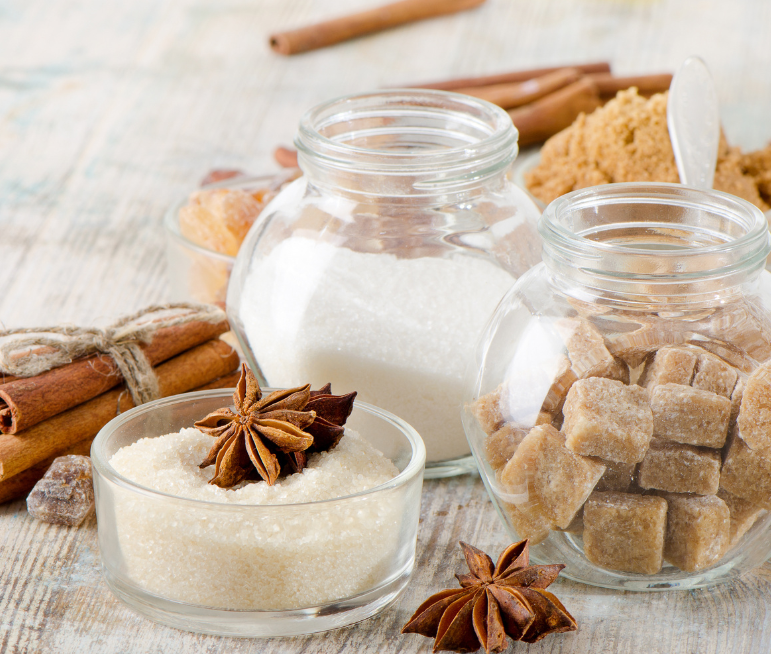
Six tips to better manage sugar and get better
The place of sugar in our daily lives
By Jessie Inchauspé - Biochemist and author of Make your glucose revolution
Most of us have too much sugar in our bodies and it creates problems for us. For example: cravings, sluggishness, fertility problems, weight gain, sleep that is not very restful... And in the long term, we can develop diseases like type 2 diabetes .
So what I did was I gathered over 300 super recent studies that allow everyone, and have allowed me, to avoid these glucose spikes to improve physical and mental health .
So I'll give you an example: I grew up eating a Nutella pancake every morning, so at 7:30 a.m. And at 10am I was super hungry but I thought that was normal. In fact what was happening was that my Nutella pancake created a big spike in glucose, then a drop and by 10am, I was super hungry. In fact, if we eat something sweet in the morning, we create this glucose cycle, a roller coaster all day long. We have cravings all day, we are super hungry all day and we want to eat more and more sugar. So what we do in the morning: we eat salty instead of sweet. Savory can be bread with cheese, bread with half an avocado, a small omelette that you make quickly in the morning. For those of us who don't eat breakfast by the way, it's completely a personal choice, it's whatever you want but the most important thing is how you break the fast. The first thing we eat, whether at 7 a.m. or 1 p.m., must be salty food. We thus avoid the drop in glucose 2 hours after the meal, which generally leads to fatigue, cravings, cravings for sweets... And then in the evening we sleep better, we age less quickly internally, we have more concentration. Things recover pretty quickly and the impact is pretty awesome.
Eat foods in the correct order
If you eat the foods in the meal in a specific order, you significantly reduce the glucose peak of the meal. The correct order is: vegetables first, then proteins and fats, then starches and sugars.
Example meal: steak-fries-salad. We eat the salad first, then the steak and finish with the fries. After a meal we finish with a dessert and be careful, all sugars are the same: white sugar, brown sugar, honey or agave syrup, they are the same molecules, the impact is the same on the body. Sugar is for pleasure, it's not for health.
We must imagine that our stomach is like a sink with the intestine as the drain pipe. When we eat vegetables first in a meal, the vegetables go into the sink, then into the drain where they form a protective shield. If then, later, we add starchy foods or sugars, thanks to the protective shield, the glucose molecules will be less absorbed into the blood. So we will have fewer glucose peaks and fewer symptoms.
Dress Your Carbs
When eating starchy foods, like pasta, rice or bread, or sweet things like fruit or dessert, it's important not to eat them alone. If you're used to eating a plain pasta dish, those are naked carbohydrates and it's important to put them in clothes. Clothes could be small tomatoes, a little parmesan, a little spinach, maybe an egg. We add proteins, we add fiber, we add fats to reduce the speed at which the glucose from the pasta enters the blood to avoid the glucose peak and then the drop 2 hours later.
Add vinegar to your life
In fact, vinegar has an incredible impact on our blood sugar levels, it truly is a magical ingredient. So what we do is that we either add a little vinegar to our vegetable-based starter or, if we are motivated, we take a large glass of water, we put a spoonful of vinegar in it. and o drink this before meals. This will reduce the glucose peak of the meal by 30%. So you can eat the same thing as usual afterwards, but by adding vinegar at the start of the meal, you will avoid having a peak that is too big and having a drop that is too big too.
All vinegars work: cider vinegar, sherry vinegar, wine vinegar, there is no difference, take the one you like. The only thing to avoid is balsamic vinegar, very thick balsamic syrup, full of sugar. This one is going to have a little less impact because it contains sugar but otherwise, it's up to you.
If you don't like vinegar at all, you can also use lemon juice. It's not quite as effective as vinegar, but it still has benefits.
Exercising right after a meal
We all know that you have to do sport, that it is good for your health. But I will tell you that the best time to do it is after meals. So within an hour after a meal, try to use your muscles for 10 minutes. It doesn't have to be very complex, you can just walk around the block, take the stairs twice, or dance to a few songs in your living room. What is important is to contract your muscles for 10 minutes within an hour after the meal. The muscles, when contracting, need energy and this energy, they will draw it first from your blood, they will seek the glucose from the meal in the blood. So when we use the muscles after a meal, we reduce the glucose peak that will come afterwards. As a result we are less tired, we don't have a coma 2 hours after the meal. It’s really helpful for energy!
Snack salty
When snacking between meals, it is always better to think salty than sweet.
Here are the worst things to snack on: fruit juices, because when you squeeze a fruit, you remove the fibers from the fruit so there are no more protective fibers at all. We extract all the sugar from the fruit and we get a huge spike in glucose and fructose which is not good for your health.
All I share are principles based on the biochemistry of your body but above all they are tools to make your own. It's up to you to deal with it, when you think about it, when it's easy. The goal is not to go on a drastic diet, but just to understand how our body works and try to help it when we think about it.
Products
View all
